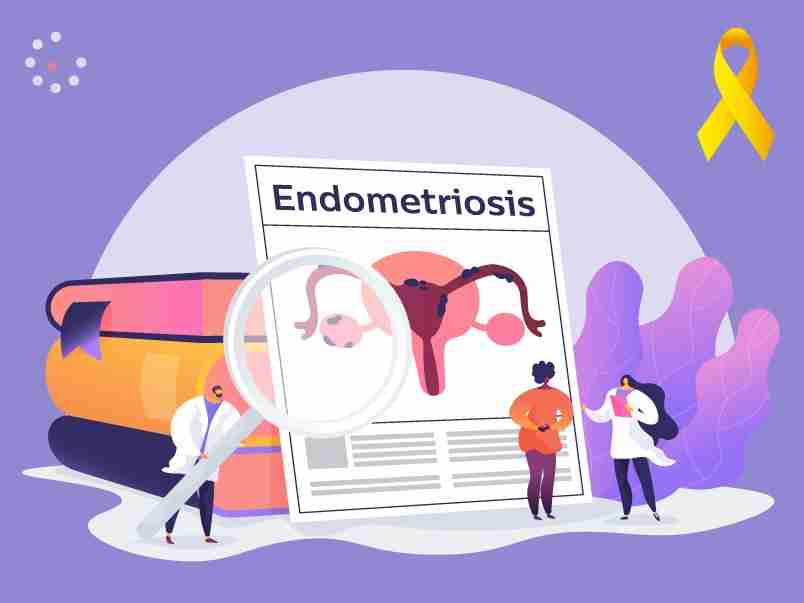Table of contents
Endometriosis is a common medical condition where endometrial tissue grows on the outside of the uterus and affects 1 in 10 women in their fertile years.
The endometrium is the most internal part of the uterus, which grows and detaches from the uterus each month when a woman gets her period. With endometriosis, the type of tissue is like the lining of the uterus, but it grows externally, creating endometrial “implants” that can affect the fallopian tubes, the ovaries, the uterine ligaments, the bladder or the bowel.
What are the symptoms of endometriosis?
The most common symptoms of endometriosis can appear as severe pelvic and/or abdominal pain during menstruation, discomfort during or after sex, or painful periods with abundant bleeding. Another symptom that is associated with endometriosis is the difficulty in getting pregnant (infertility), which is often diagnosed when a woman undergoes assisted reproductive treatment when she is unsuccessful in her attempts to become pregnant.
How to diagnose endometriosis?
Nowadays, a high-resolution ultrasound scan, such as the ones we use at Tambre, is sufficient to diagnose endometriosis.
Occasionally, laparoscopy may be used. This is a surgical procedure in which a small incision is made in the abdomen and a camera is inserted to see inside the pelvic cavity. The doctor will then make a diagnosis based on what the endometrial implants look like.
Why is it important getting diagnosed for endometriosis?
Endometriosis often appears at the same time as a woman’s first period. This situation may lead many women to think that the intense discomfort they feel is associated with the “normal” pain of menstruation, when in fact it may be due to endometriosis.
It is also a progressive condition that can get worse over time. One of the most common consequences associated with endometriosis is infertility, but with an early treatment it can be avoided.
That’s why it is very important to reach out to a specialist as soon as you notice any symptoms that may be related to this medical condition. Early diagnosis can prevent further complications, help to slow the progression of the disease, and keep it under control.
What are the treatments for endometriosis?
The treatment of endometriosis depends on the symptoms that each woman has and the results she wants to achieve. It may be because she wants to reduce the pain or because she is trying to get pregnant. In either situation, it is very important to keep an eye on endometriosis in order to detect and avoid any possible problems in the future.
Treatment pathways for endometriosis involve medication or surgery.
- Treatment with medication. The most frequently prescribed medication is birth control pills containing a combination of oestrogen and progesterone or progestogens alone. If these remedies do not produce the desired result, gonadotropin-releasing hormone (GnRH) antagonists can be used to prevent and inhibit ovulation.
- Surgery is recommended when the pain is very intense, when there are large ovarian cysts and in case of urinary or intestinal disorders. Laparoscopic surgery is sometimes suggested to explore and remove the tissue causing the problem. This can relieve symptoms in most people with endometriosis. However, this is not always effective and further surgical treatment is common.
How can I get pregnant if I have been diagnosed with endometriosis?
Most women with endometriosis experience difficulties in getting pregnant. This is due to pelvic implants and adhesions that can affect the functioning of the fallopian tubes and interfere with a pregnancy. However, depending on the degree of endometriosis and the age of the patient, there are assisted reproductive techniques that can help women achieve pregnancy.
The most common technique for women with endometriosis who are unable to get pregnant naturally is In Vitro Fertilisation (IVF), although for women who have already undergone this procedure unsuccessfully, egg donation is recommended.
Surprisingly, there can be an improvement in many cases of endometriosis after during and after pregnancy. The relief of symptoms may be due to the following reasons:
- During pregnancy the ovaries are in a quiet state.
- After pregnancy the hormonal cycle may change.
- Due to breastfeeding, there is an increase in prolactin which leads to a decrease in endometriosis.
If you are interested in a diagnosis, we look forward to welcoming you at our clinic in Madrid. At Tambre we provide personalised assistance from the very first moment and our professionals will be pleased to consider your case and suggest the most suitable options for you. To book your first visit, feel free to fill in our contact form and send us your details describing your case.

